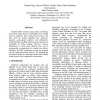Free Online Productivity Tools
i2Speak
i2Symbol
i2OCR
iTex2Img
iWeb2Print
iWeb2Shot
i2Type
iPdf2Split
iPdf2Merge
i2Bopomofo
i2Arabic
i2Style
i2Image
i2PDF
iLatex2Rtf
Sci2ools
ICDAR
2009
IEEE
2009
IEEE
Camera-Based Ballot Counter
Portable ballot counters using camera technology and manual paper feed are potentially more reliable and less expensive than scanner-based systems. We show that the spatial sampling rate, geometric linearity, point-spread function, and photometric transfer function of off-the shelf consumer cameras are acceptable for ballot imaging. However, scanner illumination is much more uniform than can be economically accomplished for variable size ballots. Therefore flat-field compensation must be designed into the image processing software. We illustrate the mechanical design of a prototype camera-based ballot reader based on our comparative observations.
Ballot | Document Analysis | ICDAR 2009 | Portable Ballot Counters | Prototype Camera-based Ballot |
| Added | 21 May 2010 |
| Updated | 21 May 2010 |
| Type | Conference |
| Year | 2009 |
| Where | ICDAR |
| Authors | George Nagy, Bryan Clifford, Andrew Berg, Glenn Saunders, Daniel P. Lopresti, Elisa H. Barney Smith |
Comments (0)

